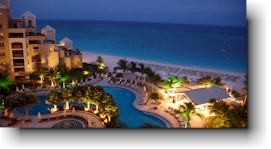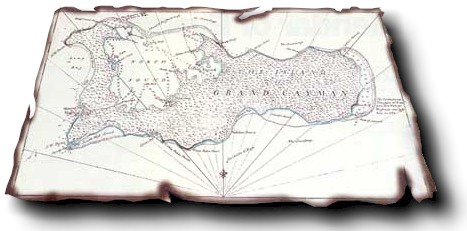ISLAND HISTORY
 |
|
|
Milestones In Our History
|
1503 Columbus sights the Sister
Islands and names them 'Las
Tortugas'. Over the next 100 years
the name 'Caymanas' or Cayman
becomes common
1526 The first map to show the
Cayman Islands with any accuracy is
made by Juan Vespucci. Like previous
mapmakers, he wrongly shows the
three islands as a triangular group,
but he is the first cartographer to
show them correctly in relation to
Jamaica and Cuba, and the first to
give them a form of their present
name: Caymanos. Vespucci is a nephew
of Amerigo Vespucci, the man after
whom America was named |
|
|
|
|
1586 Sir Francis Drake's fleet
of 23 ships stops for two days at
Grand Cayman. The island is not
inhabited by humans, but crocodiles,
alligators, iguanas and numerous
turtles are sighted
1630 The Dutch warship Dolphijn,
separated from its fleet, crashes
into Grand Cayman's northern reefs.
Though the ship is wrecked, the crew
save themselves and salvage their
cannon 'as well as some provisions.
The captain and crew of more than
120 men and boys spend 16 weeks on
the island, building a small vessel
from the planks of the Dolphijn. The
new boat, named Cayman, gets them as
far as Cuba, where they are taken
onto the ships of another Dutch
fleet
1655 England captures Jamaica
from the Spanish
1669 Little Cayman is attacked
by Spanish forces under the command
of Manuel Rivero Pardal. Several
Jamaican turtling vessels are sunk
and others seized. The presence of
turtlers' huts (which the Spanish
burn) in April, before turtling
season was underway, suggests that
there may have been more than a
seasonal settlement there |
|
Bodden
Town, Cayman's first capital
Originally called "South
Side", the name Bodden Town
appears to have first been
used in 1773 when a visiting
British navy surveyor,
noting the predominance of
families with the name "Bodden",
remarked: "At this time
there are 21 families at the
South Side, which we have
called Bodden Town." |
|
|
1670 Under the Treaty of Madrid,
Spain recognises England's
sovereignty over Jamaica and Cayman,
and various other Caribbean islands
1700s Permanent settlement has
probably begun by this time with a
few families, notably Boddens,
living on Grand Cayman
1734-42 Five land grants in
Grand Cayman are made by the
Governor of Jamaica. Mahogany and
logwood are being exported to
Jamaica. Population perhaps 100-150
1735 Grand Cayman's first land
grant is enrolled at Spanish Town,
Jamaica, for 3000 acres, to Daniel
Campbell, John Middleton, and Maty
Campbell. The location of their
house is most likely where the
runway of Owen Roberts International
Airport now lies
1773 First survey 'map' of
Cayman is made by the Royal Navy.
Population is 400, approximately
half free, half slaves |
|

A 1773
map by George Gauld, courtesy of the
Cayman Islands National Archives
|
|
1780 William Eden builds the
"Great House" as a residence and
community refuge, calling it Pedro
St. James
1780s Cotton, turtle,
sarsaparilla and wood being exported
to Jamaica
1790 Fort George is constructed,
probably to ward off attacks by
French or Spanish
1794 'Wreck of the Ten Sails'
occurs off East End. Miraculously,
only eight people drown
1798 First record of a
Magistrate in Cayman being appointed
by Governor of Jamaica. Bodden Town
served as the seat of government for
many years. William Bodden, resided
here, and served as Chief Magistrate
or "Custos" from 1798 until his
death in 1823. Unofficially, he was
thought of as a "Governor" |
|
Bodden Town, Cayman's first
capital
Although no one recalls
there ever being a "house"
on this site, reference is
made to a "Guard House" in
Bodden Town in "The Local
laws of Grand Cayman", a
document produced during the
1830s. It's located about a
quarter-mile west of Turtle
Nest Inn (at the approach to
the town). It seems to have
been the site of one of the
former capital's three lines
of defense against invading
pirates and Spanish
"marauders". The local
"militia" are believed to
have manned the position,
and the Guard House was
their accommodations |
|
|
1802 The first census to be
carried out lists 933 residents,
more than half of whom are slaves.
Thirty tons of cotton are exported
from Grand Cayman. Cotton surpasses
mahogany as the Cayman Islands'
principal export, but the cotton
boom will be short-lived
1820s Local laws being passed by
a self-appointed group of "principal
inhabitants"
1830s First missionaries from
the Anglican and Wesleyan churches
visit, a church is built in George
Town and first schools established
1831 Decisions to form an
elected Assembly taken at Pedro St.
James on December 5th. Elections
follow and a new Assembly passes
first legislation on December 31st.
Population is 2000 |
|
|
|
|
1835 Governor Sligo of Jamaica
lands in Cayman to declare all
slaves free in accordance with the
Emancipation Act of 1833. By this
period the slave population of the
islands outnumbers whites five to
one
1830s-40s First schools
established by the Mico Charity and
Wesleyans
1830s-50s Fearing that the
Emancipation Act will result in a
loss of political power and
agricultural production, hundreds of
Caymanians emigrate to the Bay
Islands of Honduras and Belize
1850 The first Brac-built
schooner, a 26-footer, is completed.
The largest vessels built in the
islands at this time are about 45
tons. Most turtling schooners remain
at between 40 and 50 tons. By the
early 1900s, though, the schooners
built for the lumber trade reach 100
tons. The largest Caymanian schooner
to be built is a 250-ton vessel
|
|
Bodden Town, Cayman's first
capital
Slave Wall, just a short
walk west of Turtle Nest
Inn, was probably built
before the 1835 abolition of
slavery in the Cayman
Islands. It is said that a
slave of Spanish origin
named "Drummond" supervised
a seven-foot section which
led to the wall often being
called "Drummond's Wall". |
|
|
1863 Act of the Imperial
Parliament in London makes Cayman a
dependency of Jamaica
1888 Edmund Parsons appointed as
the first paid "custos" or Chief
Executive Officer of Government
1898 Frederick Sanguinetti, an
official of the Jamaican Government,
is appointed as the first
Commissioner of the Cayman Islands.
Cayman will be governed by
commissioners until 1962
1911 Population of the Cayman
Islands is 5,564
1920 Education Act provides for
schools in all districts
1932 The '32 Storm devastates
the Sister Islands, and, to a lesser
extent, Grand Cayman. More than 100
lives are lost; no family is left
unaffected |
|
|
|
|
1937 The first cruise ship
visits the Cayman Islands. The SS
Atlantis calls on February 22nd. It
weighs 16,000 tons and carries 450
wealthy, mostly elderly passengers,
more then three-quarters of whom
come ashore for the day. The first
tourist booklet is published
1939-45 During World War II a
"Home Guard" is formed to provide
protection and surveillance of enemy
shipping
1942 On May 29th the Alister, a
steamship on the Jamaican line owned
by James Webster, formerly of Bodden
Town, is torpedoed and sunk by a
German submarine just south of East
End Lighthouse
1942-1945 A U.S Naval Base and a
U.S. coast Guard Base operate in
Grand Cayman |
|
Bodden Town, Cayman's first
capital
Gun Square, just a short
walk east of Turtle Nest
Inn, is believed to be one
of Bodden Town's two defence
points, the other being the
Guard House at the western
approach of the town. It was
an important battery as it
overlooked one of the
principal channels of the
day. Two 18th century
cannons are still located on
the site. |
|
|
1950s A number of hotels open as
tourism begins to increase
1953 An airfield is opened in
Grand Cayman, eventually replacing
the seaplane service which has
operated since the 1940s. . The
George Town hospital is opened.
Barclays Bank, the first commercial
bank, opens
1954 Costa Rican national
airline, LACSA, provides the first
scheduled air service to Cayman
Brae. The 1,200-foot strip airstrip
on the Brae is built entirely by
volunteers for a total cost of £1
,600
1958 The official Cayman Islands
coat of arms is adopted. The winning
design, selected by a committee of
the Legislature, was submitted by a
non-Caymanian, James Ford
1959 Cayman receives its first
written constitution, which grants
the vote to women. Cayman ceases to
be a dependency of Jamaica |
|
Bodden Town, Cayman's first
capital
Queen Victoria Monument, a
short stroll west from
Turtle Nest Inn, was erected
to the memory of Queen
Victoria sometime between
1907 and 1912. In the 1920s
and 1930s, it was the
regular meeting site for the
men of the district who
gathered there to discuss
politics. The tradition has
continued to modern times. |
|
|
1962 Following Jamaica's
independence from Great Britain,
Cayman chooses to remain a Crown
Colony, governed by an Administrator
who reports directly to Westminster
1966 The Mosquito Research and
Control Unit is created. By the
early 1970s it has reduced the
mosquito plague significantly,
enabling tourism to flourish.
(Mosquito-control campaigns in the
late 1940s and 1950s had already
succeeded in wiping out the species
that carried malaria and yellow
fever). Landmark legislation to
encourage banking Industry is
introduced
1966 On May 10th, Caribbean
Utilities Company (CUC) commences
operations as the sole provider of
electricity to Grand Cayman,
inheriting 650 customers, an
installed capacity of 1.36 megawatts
with a peak load of 900 kilowatts,
and 52 employees
1970 Population of the Cayman
Islands is 10,249 with only 403
visitors during the year |
|
Bodden Town, Cayman's first
capital
In March 1999, Turtle Nest
Inn opens in Bodden Town,
and is Grand Cayman's first
intimate and independent
beachfront hotel. And,
exactly 500 years after the
first recorded sighting of
the Cayman Islands, in 2003,
Turtle Nest Inn wins
Cayman's only "Editors'
Choice Award" from Travel
Holiday magazine !!! |
|
|
1972 New Constitution introduced
under which Cayman is governed by a
Legislative Assembly, Executive
Council and a Governor
1987 The National Trust for the
Cayman Islands is established.
Cayman National Cultural Foundation
is founded the same year
1998 The restored Pedro St James
National Historic Site is opened to
the public
2003 In January, CUC (Grand
Cayman's electricity provider) has
about 20,000 customers, an installed
capacity of 115 megawatts with a
peak load of 76 megawatts, and 215
employees
2003 Present population is
approximately 40,000 with about
303,000 stay-over visitors (in
2002), and about 1,575,000 cruise
ship visitors
(Thanks to the National Trust for
the Cayman Islands, CUC, and the
magazines "Horizons" and "Key to
Cayman") |
|
|
|
|
|
|
|